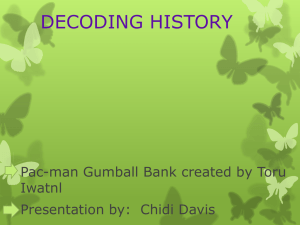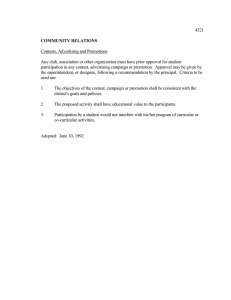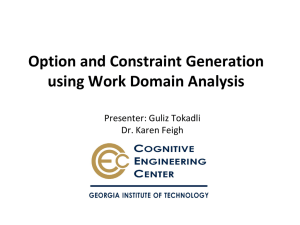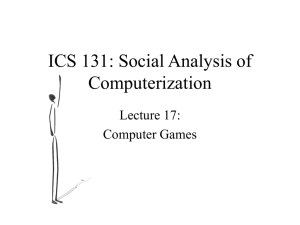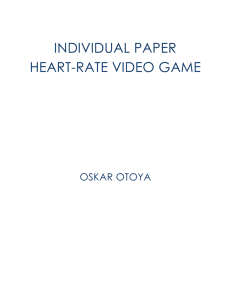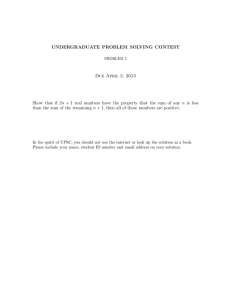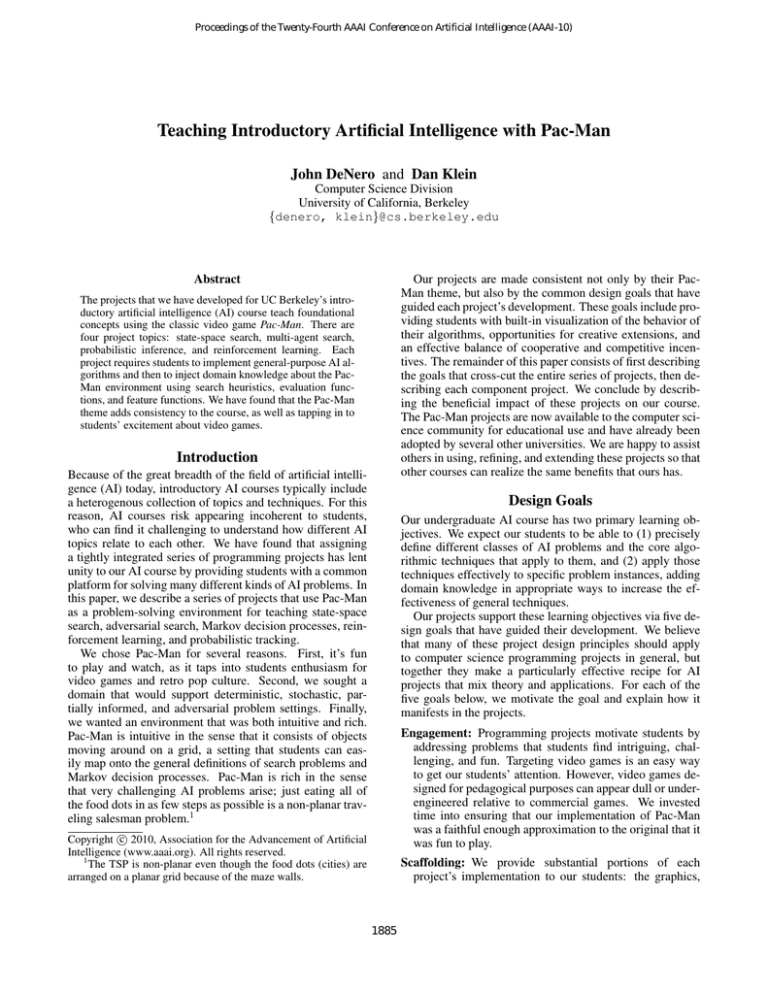
Proceedings of the Twenty-Fourth AAAI Conference on Artificial Intelligence (AAAI-10)
Teaching Introductory Artificial Intelligence with Pac-Man
John DeNero and Dan Klein
Computer Science Division
University of California, Berkeley
{denero, klein}@cs.berkeley.edu
Abstract
Our projects are made consistent not only by their PacMan theme, but also by the common design goals that have
guided each project’s development. These goals include providing students with built-in visualization of the behavior of
their algorithms, opportunities for creative extensions, and
an effective balance of cooperative and competitive incentives. The remainder of this paper consists of first describing
the goals that cross-cut the entire series of projects, then describing each component project. We conclude by describing the beneficial impact of these projects on our course.
The Pac-Man projects are now available to the computer science community for educational use and have already been
adopted by several other universities. We are happy to assist
others in using, refining, and extending these projects so that
other courses can realize the same benefits that ours has.
The projects that we have developed for UC Berkeley’s introductory artificial intelligence (AI) course teach foundational
concepts using the classic video game Pac-Man. There are
four project topics: state-space search, multi-agent search,
probabilistic inference, and reinforcement learning. Each
project requires students to implement general-purpose AI algorithms and then to inject domain knowledge about the PacMan environment using search heuristics, evaluation functions, and feature functions. We have found that the Pac-Man
theme adds consistency to the course, as well as tapping in to
students’ excitement about video games.
Introduction
Because of the great breadth of the field of artificial intelligence (AI) today, introductory AI courses typically include
a heterogenous collection of topics and techniques. For this
reason, AI courses risk appearing incoherent to students,
who can find it challenging to understand how different AI
topics relate to each other. We have found that assigning
a tightly integrated series of programming projects has lent
unity to our AI course by providing students with a common
platform for solving many different kinds of AI problems. In
this paper, we describe a series of projects that use Pac-Man
as a problem-solving environment for teaching state-space
search, adversarial search, Markov decision processes, reinforcement learning, and probabilistic tracking.
We chose Pac-Man for several reasons. First, it’s fun
to play and watch, as it taps into students enthusiasm for
video games and retro pop culture. Second, we sought a
domain that would support deterministic, stochastic, partially informed, and adversarial problem settings. Finally,
we wanted an environment that was both intuitive and rich.
Pac-Man is intuitive in the sense that it consists of objects
moving around on a grid, a setting that students can easily map onto the general definitions of search problems and
Markov decision processes. Pac-Man is rich in the sense
that very challenging AI problems arise; just eating all of
the food dots in as few steps as possible is a non-planar traveling salesman problem.1
Design Goals
Our undergraduate AI course has two primary learning objectives. We expect our students to be able to (1) precisely
define different classes of AI problems and the core algorithmic techniques that apply to them, and (2) apply those
techniques effectively to specific problem instances, adding
domain knowledge in appropriate ways to increase the effectiveness of general techniques.
Our projects support these learning objectives via five design goals that have guided their development. We believe
that many of these project design principles should apply
to computer science programming projects in general, but
together they make a particularly effective recipe for AI
projects that mix theory and applications. For each of the
five goals below, we motivate the goal and explain how it
manifests in the projects.
Engagement: Programming projects motivate students by
addressing problems that students find intriguing, challenging, and fun. Targeting video games is an easy way
to get our students’ attention. However, video games designed for pedagogical purposes can appear dull or underengineered relative to commercial games. We invested
time into ensuring that our implementation of Pac-Man
was a faithful enough approximation to the original that it
was fun to play.
c 2010, Association for the Advancement of Artificial
Copyright Intelligence (www.aaai.org). All rights reserved.
1
The TSP is non-planar even though the food dots (cities) are
arranged on a planar grid because of the maze walls.
Scaffolding: We provide substantial portions of each
project’s implementation to our students: the graphics,
1885
time for the course staff, but also allows us to provide
immediate feedback to students when they submit their
projects. We automatically e-mail them requesting a resubmission if their projects generate syntax errors, throw
exceptions, or fail simple test cases.
These design goals have guided the format of our projects.
We also focused on the following two design goals to guide
our decisions in selecting project content.
Separating Algorithms from Problem Instances
The usefulness of most artificial intelligence techniques
comes from the fact that the same algorithms, and in fact
the same implementations, can operate on a wide variety of
problem instances. One risk of focusing on a common problem setting throughout our course is that students may fail to
appreciate that the techniques also apply much more broadly
than simply to playing Pac-Man.
To emphasize the generality of AI techniques, we instruct
students to provide problem-agnostic algorithm implementations. For instance, they write search and reinforcement
learning algorithms against general interfaces for search
problems and Markov decision processes, respectively. To
enforce generality, we including multiple different problem
instantiations for some projects. For example, the students’
search code won’t receive full credit unless it solves the 8puzzle in addition to Pac-Man related search problems. Similarly, their reinforcement learning code must apply to the
grid world from our course textbook (Russell and Norvig
2003) and a simulated robot controller, as well as Pac-Man.
We also believe that students should gain experience in
adding domain-specific knowledge to their AI algorithms
(learning objective 2) in the form of search heuristics, search
problem definitions, evaluation functions for adversarial
games, and features for linear approximations of expected
reward. One benefit of reusing the Pac-Man environment
across projects is that students quickly become domain experts on our implementation of Pac-Man. This consistency
reduces the risk that students will fail at the domain-specific
aspects of our projects simply because they didn’t understand the domain well. Another benefit is that students can
directly compare the formats of domain knowledge consumed by different AI techniques because they all address
a common domain.
Figure 1: The search project visualizes an execution trace
of each search algorithm when applied to the simple case of
finding a path through a maze to a fixed location. Above,
the states explored in breadth-first graph search are colored,
with their shade indicating the order in which they were dequeued from the fringe.
game mechanics, object-oriented modularization, utility
classes, and agent interfaces are all provided. Moreover,
we ensure that each project already “runs” out of the box
by providing implementations for rudimentary baseline
agents (e.g., a Pac-Man controller that always moves left
until it hits a wall). We have found that this amount of
code scaffolding allows students to focus primarily on the
AI topics, rather than struggling to implement software
from scratch based only on a specification.
Visualization: We have designed each project so that as
soon as students implement an algorithm, they can visualize its behavior. For example, as soon as they implement
uniform-cost search, they can watch Pac-Man walk efficiently through a maze. Providing visual feedback is rewarding, and it additionally provides students with useful
information as they debug their implementations. Where
possible, we also visualize aspects of the execution trace
of their algorithms. For example, we show the states explored by their search algorithms in the order that they are
dequeued from the fringe, as in Figure 1.
Consistency: All of the projects use a common code base
that provides a consistent interface for implementing PacMan agents and querying the current game state. Sharing code across projects dramatically reduces the start-up
time and confusion in later projects.
Grading: The fixed scaffolding allows us to grade large
portions of the projects programmatically using scripts.
This grading approach has several advantages: it saves
Promoting Collaboration and Competition
Students vary in how they react to collaborative and competitive scenarios. Some students are motivated by competition,
while others prefer to be evaluated in absolute terms. Most
learn effectively in collaborative context, while some prefer
to work alone. In designing the Pac-Man projects, we have
aimed to foster but not force collaboration in the core work,
while at the same time providing optional competitions. In
this way, we have been able to address the learning needs of
a wide variety of students.
We designed our projects to be completed in pairs, but we
allow students to work alone with no reduction in project requirements. This structure naturally encourages group work
1886
without mandating it. We also found that grading on an absolute scale strongly promotes informal collaboration. For
example, we use a newsgroup for course communication;
the willingness of students to answer each other’s questions
increased dramatically when we switched from a relative
to an absolute grading system. We explicitly promote an
awareness that the competitive aspects of the projects are restricted to optional contests.
That said, several projects include an optional competition that extends the required material. For instance, the
search project concludes with a contest to find the shortest
path in an intractable traveling salesman problem, after they
have solved easy instances exactly using A*. Similarly, the
reinforcement learning project concludes with a feature design challenge. These contests are much more open-ended in
character than the main projects, but are evaluated by clear
quantitative measures that ensure fairness and transparency
in our evaluation.
Although we offer only a small amount of extra credit for
winning a contest, participation can range as high as 50% of
the class. In particular, we have found that contests which
directly extend required projects attract more participation
than stand-alone contests: extensions require no additional
start-up cost for the students and often allow students to
implement ideas that occurred to them during the required
portions of a project. The open-ended character allows students to think creatively about solving hard problems, and
the competitive framework allows our strongest students to
demonstrate their talents. We also view optional contests as
opportunities for students to explore AI ideas beyond those
required for the course.
We recognize the winners of our contests in lecture and
describe their solutions to the class. Even the students who
do not choose to participate in the contests enjoy learning
about the most effective solutions to these challenging problems. Because the contests are optional and have little impact on the grading of the course, student reactions to the
contests have been extremely positive.
Figure 2: The multi-agent search project emulates classic
Pac-Man, but using smaller layouts and clearly parameterized non-deterministic ghost behaviors.
methods in previous classes, they often struggle to implement the graph search algorithms that this project requires.
To aid their development, we provide a visualization of the
exploration pattern of the search space for the simple maze
navigation search problem, as shown in Figure 1.
For large mazes, we know of no heuristic that is sufficiently tight to enable A* to efficiently find the shortest path
that consumes all food dots. The optional contest extension
for the search project asks students to find the shortest path
they can in a large maze, either through inadmissible heuristics, greedy techniques, or whatever extensions they devise
on their own.
Multi-Agent Search
The second project models Pac-Man as both an adversarial
and a stochastic search problem. Students implement minimax and expectimax algorithms, as well as designing evaluation functions for limited-depth search. This project begins by asking students to design a reflex agent, so that they
can compare the behaviors that emerge from adversarial and
stochastic search with the behaviors that they specified by
hand using their knowledge of the domain. A screenshot for
this project appears in Figure 2
We challenge students in this project to generalize the
two-player adversarial search algorithms that we present in
the textbook and in lecture to the case where there is one
maximizer (Pac-Man) and many minimizers (the ghosts),
which act in a fixed sequential order. Rather than attempting
to visualize the game trees explored by their algorithms in
this project, we tell the students what behavior they should
observe in some very simple test scenarios to help them debug their implementations.
We grade their solutions by ensuring that all actions they
choose are optimal under the modeling assumptions relevant
to each question (stochastic or adversarial, with a fixed limited depth). In the case of this project, automatically grading
their submissions with scripts is much more effective than
manually inspecting their code.
The optional contest for this project asks students to design the best evaluation function they can for playing PacMan. We suggest that they define their evaluation functions
Project Descriptions
Each project consists of a detailed description and a large
amount of scaffolding code with clear directions for students
on where to add their implementations of algorithms, heuristics, etc. We describe the projects in the order that we assign
them in our course.
State-Space Search
Students implement depth-first, breadth-first, uniform cost,
and A* search algorithms. These algorithms are used to
solve navigation and traveling salesman problems in the PacMan world. In particular, we provide a search problem definition for navigating to a particular position in a maze. Students create a new search problem definition for finding a
path that passes through all of the food dots in the maze: a
much more challenging problem. They design and implement search heuristics for both a simple special case of the
all-dots search problem and the full problem itself.
Although many students have seen uninformed search
1887
Figure 4: In the probabilistic tracking project, students compute belief distributions over the location of unobserved
stochastic ghosts, which we visualize as heat maps overlaying the game board.
Figure 3: Our graphical output for the gridworld environment includes overlays for values, q-values, and agent simulations. We also support manual control via the keyboard,
so that students can set up particular scenarios and see the
effects of q-learning updates.
We visualize the output of student models by computing the marginal distributions over each ghosts’ position
and overlaying those distributions onto the Pac-Man game
world, as shown in Figure 4. The visualization is particularly useful when students compare the behavior of exact
and approximate inference. There is currently no contest
extension for this project because at this point in our course
we instead encourage students to focus their energy on the
integrative multi-agent contest below.
as linear functions of features so that they can experiment
with learning feature weights in the following project.
Reinforcement Learning
Students implement model-based and model-free reinforcement learning algorithms, applied to the gridworld environment that is used as a running example in Artificial Intelligence, A Modern Approach (Russell and Norvig 2003).
They then apply their code to both Pac-Man and a simulation of a crawling robot. The project requires students to
implement value iteration, q-learning, and q-learning with
linear function approximation. Students develop their algorithms against a fully functional Markov decision process
implementation of gridworld that includes both graphical
and text output. The graphical output visualizes the state
of their learning algorithms, as in Figure 3.
The optional contest for this project asks students to design feature functions for an approximate q-learning PacMan agent that can be effectively trained in only a few training iterations. Students find that they cannot always reuse
all of the features they designed for the multi-agent project
because of approximation errors during learning.
Integrative Multi-Agent Contest
Our students’ enthusiasm for the contest extensions of the
early projects prompted us to develop a larger-scale contest that integrated several techniques from the course. The
multi-agent contest focuses on a head-to-head capture-theflag-style variant of Pac-Man in which each student entry
must coordinate multiple agents that shift between ghosts
and Pac-Man to simultaneously defend their own dots and
try to eat the opponent dots. Figure 5 shows an example
state from the game. To encourage the use of probabilistic
inference, we hide the positions of opponent agents and provide only noisy relative position observations. Effective entries for this contest combine search, adversarial search, and
probabilistic tracking, and exploit various domain-specific
strategies.
We announce this project early in the course as an example of the kind of problem that requires integrating multiple
AI techniques. Although the contest is optional and rarely
has a material effect on student grades, over a third of the
students usually participate, and the winning entries are always impressive. We allow teams of up to five students to
work together. We have successfully held live play-offs that
result in several hours of shouting, cheering, and frantic code
editing as student teams pit their entries against one another
to determine a contest winner. We also provide infrastruc-
Probabilistic Tracking
Teaching probabilistic inference in the context of Pac-Man
required us to invent a new game variant with partial information. In this project, Pac-Man is hunting ghosts that are
unobserved, but which give noisy observations about their
relative location to the Pac-Man agent. Probabilistic inference for hidden Markov models and dynamic Bayes nets
track the movement of these invisible ghosts. Students implement exact inference using the forward algorithm and approximate inference via particle filters.
1888
Figure 5: The multi-agent course contest integrates several techniques from the course, including state-space search, adversarial
search, and probabilistic tracking. Each team (red vs. blue) controls multiple agents that shift between ghosts (defense) and
Pac-Man (offense) as they simultaneously defend their own dots and try to eat the opponent dots.
projects have also been successful. In particular, we are very
happy with grading on an absolute scale so that students will
not be discouraged from assisting each other. We now have
a very active online newsgroup in which students answer
a majority of the questions that are posed. We have also
found that automatically grading projects has several advantages, not only in time saved, but in providing students with
early feedback about whether or not their code successfully
runs on simple test cases. Finally, we have learned that contests provide an excellent outlet for strong students to explore the course material and demonstrate their talents. Of
course, contests risk fostering an unproductive learning environment for less competitive students, but we believe that
the combination of optionality of the contests and strong encouragement of cooperation for the required projects effectively mitigates any such concerns.
We are very interested in supporting other universities in
adopting and extending these projects. Our experience so
far in sharing these projects with the faculty of universities
has been uniformly positive: at least ten courses around the
world have used the projects in some capacity. As adoption increases, we expect that the Pac-Man projects will only
continue to improve and expand in their coverage of AI topics. AI is an incredibly exciting field, and we hope that
adding a little Pac-Man flavor to courses will help undergraduate students get involved.
ture to hold nightly tournaments during the development period so that student teams can gauge the quality of their entries.
Impact of the Projects
The Pac-Man projects represent an important component of
a broader redesign of our undergraduate AI course, in which
we have removed several topics (e.g., logical reasoning and
planning) in order to focus more deeply on the remaining
topics and how to apply them. The projects have been effective in motivating students and in creating opportunities for
them to apply the general techniques they learn in lecture.
Responses to these projects have been overwhelmingly
positive. In response to the survey question, “What worked
best for you in this course?” 65% of students listed the
course projects. Enrollment in the course increased a dramatic 69% the semester after Pac-Man was first introduced,
and has increased by well over 100% in the three years since
we began introducing these projects. Along with enrollment,
student ratings about the usefulness and effectiveness of the
course have also continued to increase as we have refined
the projects.
These projects are effective in integrating the lecture and
assignment portions of the course. In lecture, Pac-Man
makes an excellent platform for demonstrations and examples. After describing a simple example on a small Pac-Man
world, we can demonstrate algorithms working on larger
problem instances and let students know that they too will
build effective solutions for these instances. Describing winning entries for the contests also integrates well with lecture
and gives students additional motivation to come to class. It
is not unusual that students will applaud after a successful
Pac-Man game.
The policies and mechanics we have developed for the
References
Russell, S., and Norvig, P. 2003. Artificial Intelligence, A
Modern Approach. Prentice Hall.
1889


